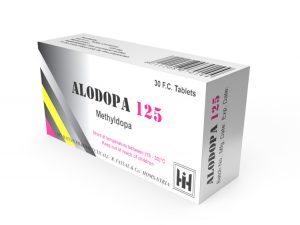
Packing :30 tab.
Form : F.C.Tablets
Theraputic Categories : Gyno& obs Drugs
Indications : Antihypertensive. (Alpha2 receptors Agonist in the brain).
Composition :Methyldopa 125 mg.
Composition and excipients:
Each ALODOPA F.C. Tablet contains:
- Active ingredients: Methyldopa 125mg or 250mg or 500mg.
- Inactive ingredients:
Core: Povidone, Cutina HR, Sodium starch Glycolate, and Talc.
Film: Eudragit EPO, Talc, Polyethylene Glycol, and Titanium dioxide.
Properties:
Alodopa (methyldopa) is a centrally acting alpha 2-adrenergic agonist which reduces sympathetic tone and produces a fall in elevated blood pressure.
– Alodopa is decarboxylated in the CNS to alpha-methylnoradrenaline which is thought to stimulate alpha 2-adrenoceptors resulting in a reduction in sympathetic tone and a fall in blood pressure. It may also act as a false neurotransmitter, and have some inhibitory action on plasma renin activity
. Alodopa reduces the tissue concentrations of dopamine, noradrenaline, adrenaline, and serotonin.
– When administered by mouth its effects reach a maximum in 4 to 6 hours following a single dose, although the maximum hypotensive effect may not occur until the second or third day of continuous treatment. Blood pressure returns to its pretreatment levels usually apparent 24-48 hours after withdrawal of methyldopa.
– To reduce the side effects. Smaller doses of methyldopa may be given in conjunction with thiazide diuretic, which would also reduce the oedema that sometimes occur with methyldopa therapy and reduces development of tolerance.
– Side effects are minimized if the daily dose is kept below 1g.
Indications:
Alodopa is used in the treatment and control of moderate to severe hypertension, usually in combination , but other agents with fewer adverse effects are generally preferred. It reduces the standing, and to a lesser extent the supine blood pressure.
Pharmacokinetics:
– Following oral administration, methyldopa is variably and incompletely absorbed, apparently by an amino-acid active transport system. The mean bio-availability has been reported to be about 50%. It is extensively metabolized and is excreted in urine mainly as unchanged drug and the O-sulphate conjugate. It crosses the blood brain barrier and decarboxylated in the central nervous system to active alpha methyl noradrenaline.
-The elimination is biphasic with a half-life of about 1.7 hours in the initial phase; the second phase is more prolonged. Clearance is decreased and half-life prolonged in renal insufficiency. Plasma protein bindings is reported to be minimal. Methyldopa crosses the placenta, small amounts are distributed into breast milk.
Contraindications:
– Alodopa is contraindicated in patients hypersensitive to methyldopa or any of its components, renal or hepatic insufficiency, porphyria, and active hepatitis, anuria, and active cirrhosis.
– Concomitant administration of Alodopa with MAOIs and L-dopa-, and patients with pheochromocytoma.
– In patients with liver diseases previously associated with methyldopa therapy.
Precautions:
– Periodic Coombs test and blood test should be performed during therapy to detect hemolytic anemia. It may be useful to do a Coombs test before therapy and at 6-12 months after the start of therapy.
– Since concomitant administration of methyldopa is associated with liver disorders. It may be useful to do periodic determination of hepatic function before therapy and during 6-12 months after the start of therapy.
– Some patients experience clinical edema or weight gain which may be controlled by use of diuretic. Methyldopa should not be cotinued if edema progresses or signs of heart failure appears.
– Treatment should be discontinued if patients experience involuntary choreoathetotic movements in subjects with severe bilateral cerebrovascular disease.
Drug Interactions:
-The hypotensive effects of methyldopa are enhanced by diuretics and other anti-hypotensive agents.
– Absorption of methyldopa was reduced by 73% and 61 %. respectively when taken with a dose of ferrous sulfate and ferrous gluconate.
– Concurrent administration methyldopa with lithium may lead to lithium toxicity, therefore, patients taking both medicines should be carefully monitored.
Pregnancy and Lactation: Pregnancy category C:
– There are no adequate and well-controlled studies with methyldopa in pregnant woman. Methyldopa should be used during pregnancy and lactation only if clearly needed and under medical observation.
Side Effects:
– Few adverse effects may occur including, dizziness, headache, weakness, and parkinsonism when higher doses are administered.
– Orthostatic hypotension, bradycardia.
– Hematological alterations including hemolytic anemia, positive Coombs test, allergic reaction, and impotence have rarely been reported.
-CNS: – Alodopa may cause sedation, it is advisable not to drive or operated machineries when taking the drug.
– Less common side effects including nasal congestion, drug fever, failure of ejaculation, decreased libido, thrombocytopenia, leukopenia, jaundice, and pancreatitis.
Dosage and Administration:
Dosge of Alodopa should be individualized.
Adults: The usual initial dose by mouth is 250 mg 2-3 times daily. Then adjusted by small increments or decrements not more frequently than every 2 days according to the response of the patient. Maximum dose is 3 g. daily.
– The usual maintenance dosage is the equivalent of 0.5 to 2 g. daily in 2-4 divided doses.
– Elderly: Initially 125 mg twice daily, increased gradually: Maximum 2 g. daily.
– Children: A suggested initial dose of 10 mg per kg body -weight daily in 2-4 divided doses. Increased as necessary until adequate response is achieved to maximum of 65 mg per kg or 3 g. daily whichever is less.
– Dosage reduction should be considered in patients with renal insufficiency.
Packing:
Box containing Alodopa ( 125 mg -250 mg – 500 mg ) 30- 50 F.C. Tablets.
Storage: Store at temperature (15-30)° C.








